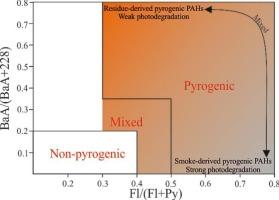“吸血鬼游戏改变者”——光降解改变了对地质样品中多环芳烃起源的解释
IF 4
1区 地球科学
Q1 GEOGRAPHY, PHYSICAL
引用次数: 0
摘要
尽管在浮游植物中发现了少量的来源,并且由于成岩过程,多环芳烃(PAHs)是公认的化合物,经常被用作燃烧标记物。在一些诊断图中所示的某些多环芳烃的特征分布用于区分热原性和非热原性多环芳烃。这些图没有显示出光降解的影响,这可能会妨碍对多环芳烃来源的正确解释。多环芳烃在抗光降解方面长达三周的差异可以改变其分布,导致典型的热原性和非热原性适应症共存。尽管它的作用毋庸置疑,但光降解并没有作为模拟地质样品中多环芳烃分布的一个因素进行讨论。广泛的分子(GC-MS)和岩石学调查结果表明,所分析的早中侏罗统(J1-J2)和早白垩统(Cr1)地层具有广泛的(2- 7环)多环芳烃分布,表明其成因为热成因,并伴有惰性岩群显微组分的主导。J1-J2和Cr1地层是通过烟源多环芳烃的作用来区分的。LMW/Total比值表明烟源多环芳烃在Cr1地层中更为常见。同时,大多数Cr1地层的4环多环芳烃分布不明显,显示了典型热原值和非热原值的共存。新提出的火灾温度指数表明,古火灾平均温度为273 ~ 425℃,j1 ~ j2与Cr1地层之间无差异。这意味着光降解是控制4环多环芳烃分布的重要因素,不明显的多环芳烃分布可以解释为大量光降解的烟雾源多环芳烃的信号。分析表明,5-7环多环芳烃没有明显的光降解。本文章由计算机程序翻译,如有差异,请以英文原文为准。

‘Vampirious gamechanger’ — photodegradation changes the interpretation of the origin of polycyclic aromatic hydrocarbons in geological samples
Despite minor sources being identified in phytoplankton and as a result of diagenetic processes, polycyclic aromatic hydrocarbons (PAHs) are well-established compounds, which are frequently used as combustion markers. The characteristic distributions of certain PAHs illustrated in several diagnostic plots are used to differentiate between pyrogenic and non-pyrogenic PAHs. These plots do not show the influence of photodegradation, which can hinder the proper interpretation of the origin of PAHs. Differences of up to three weeks in how PAHs resist photodegradation can change their distribution, leading to the coexistence of typically pyrogenic and non-pyrogenic indications. Despite its undoubted role, photodegradation was not discussed as a factor in modelling the distribution of PAHs within geological samples. The results of extensive molecular (GC–MS) and petrological surveys show that the analysed Early-Middle Jurassic (J1-J2) and Early Cretaceous (Cr1) strata contain broad (2- to 7-ring) PAHs distributions, suggesting their pyrogenic origin, which is accompanied by the domination of inertinite group macerals. J1-J2 and Cr1 strata are differentiated by the role of smoke-derived PAHs. LMW/Total ratio shows that smoke-derived PAHs are more common within the Cr1 strata. Simultaneously, most Cr1 strata are characterised by an unobvious distribution of 4-ring PAHs showing the coexistence of typically pyrogenic and non-pyrogenic values of the indicators used. The newly proposed fire temperature index shows that the average paleo-wildfire temperature was 273–425 °C with no differentiation between J1-J2 and Cr1 strata. This means that photodegradation is an important factor controlling 4-ring PAHs distribution and that unobvious PAHs distribution can be interpreted as a signal from a significant amount of photodegraded, smoke-derived PAHs. Conducted analyses suggest that 5–7 ring PAHs were not photodegraded in a significant way.
求助全文
通过发布文献求助,成功后即可免费获取论文全文。
去求助
来源期刊

Global and Planetary Change
地学天文-地球科学综合
CiteScore
7.40
自引率
10.30%
发文量
226
审稿时长
63 days
期刊介绍:
The objective of the journal Global and Planetary Change is to provide a multi-disciplinary overview of the processes taking place in the Earth System and involved in planetary change over time. The journal focuses on records of the past and current state of the earth system, and future scenarios , and their link to global environmental change. Regional or process-oriented studies are welcome if they discuss global implications. Topics include, but are not limited to, changes in the dynamics and composition of the atmosphere, oceans and cryosphere, as well as climate change, sea level variation, observations/modelling of Earth processes from deep to (near-)surface and their coupling, global ecology, biogeography and the resilience/thresholds in ecosystems.
Key criteria for the consideration of manuscripts are (a) the relevance for the global scientific community and/or (b) the wider implications for global scale problems, preferably combined with (c) having a significance beyond a single discipline. A clear focus on key processes associated with planetary scale change is strongly encouraged.
Manuscripts can be submitted as either research contributions or as a review article. Every effort should be made towards the presentation of research outcomes in an understandable way for a broad readership.
 求助内容:
求助内容: 应助结果提醒方式:
应助结果提醒方式:


